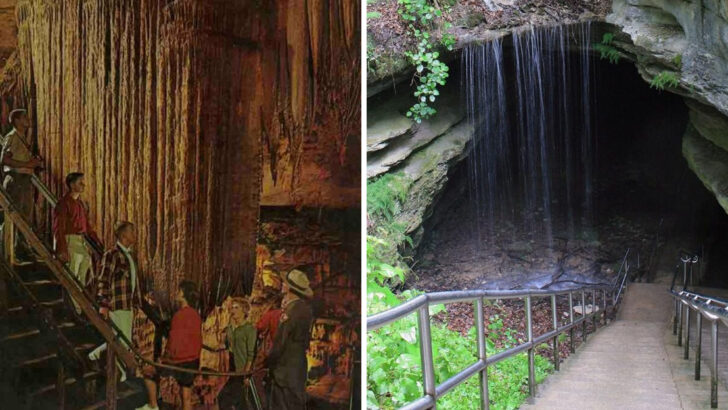Deep in the heart of Kentucky lies a natural wonder that continues to captivate explorers and tourists alike: the Mammoth Cave. Known as the longest cave system in the world, this subterranean marvel stretches over 430 miles, and new tunnels are still being discovered. The cave is not just a geological phenomenon but a living ecosystem, rich with history, unique formations, and rare wildlife. From underground rivers and waterfalls to ancient human artifacts, Mammoth Cave offers a glimpse into both the past and the mysterious beauty of the natural world.
The World’s Longest Cave System
Imagine a labyrinth so vast that after decades of exploration, new parts are still being found. The Mammoth Cave, with its astounding 430 miles of mapped passageways, holds the record as the world’s longest cave system. Its endless corridors are a testament to nature’s incredible architecture.
Explorers equipped with modern technology and age-old courage venture deep into its heart, discovering new wonders. This mighty maze beneath Kentucky still holds secrets untold, drawing intrepid adventurers. It’s a testament to the enduring allure of the unknown.
Underground Waterfalls and Flowing Rivers
Hidden beneath the earth, the Mammoth Cave is alive with the sound of water. Underground rivers like the Echo River flow through its passageways, creating hidden waterscapes few ever see. These aqueous veins carve their path through the rock, forming beautiful and secluded waterfalls.
In seasons of rain, the cave’s waterfalls become a symphony of nature, echoing through the chambers. This vibrant underground world is a reminder of nature’s relentless power and creativity. It’s a dance of water and stone, timeless and ever-changing.
Blind Cavefish and Other Rare Creatures
In the perpetual darkness of the Mammoth Cave, life has found a way to thrive in the shadows. Blind cavefish, eyeless crayfish, and translucent insects have evolved unique adaptations to survive here. These creatures, devoid of sight, navigate by other senses in this hidden world.
Their existence tells a tale of evolution, where necessity becomes the mother of invention. It’s a living testament to resilience and adaptation. Each species within this underground ecosystem plays a vital role, creating a delicate balance in this unseen universe.
Ancient Human History Carved into the Walls
Thousands of years ago, Indigenous peoples ventured into the Mammoth Cave, leaving behind traces of their presence. Archaeologists have discovered ancient torches, cane baskets, and even mummified remains within its depths. These relics provide a glimpse into early human ingenuity and life.
The cave walls tell stories, with carvings and soot marks as pages of history waiting to be read. It’s a journey into the past, where echoes of ancient civilizations still linger, whispering tales of survival, exploration, and adaptation.
Dramatic Formations Like Frozen Niagara
Among the many wonders of the Mammoth Cave, Frozen Niagara stands as a masterpiece of natural art. This formation, resembling a waterfall locked in time, is adorned with stalactites and stalagmites that glisten under the beam of a flashlight.
Visitors are often left in awe by its grandeur and beauty. It’s nature’s sculpture, crafted over millennia, showcasing the relentless and patient artistry of water and mineral. Frozen Niagara is a spectacle that invites admiration and contemplation.
Gigantic Chambers Like the Rotunda and Grand Avenue
The sheer scale of some chambers within Mammoth Cave is staggering. Rooms like the Rotunda and Grand Avenue are vast enough to accommodate entire structures. These underground cathedrals of stone evoke a sense of awe and wonder.
Walking through these giant halls, one is reminded of the cave’s monumental history and geological significance. It’s a humbling experience, standing in spaces carved by nature’s hand. Each chamber tells its own story, echoing with the whispers of time and the footsteps of explorers.
The Eerie Beauty of Gothic Avenue
Named for its cathedral-like grandeur, Gothic Avenue is both eerie and enchanting. Massive rock columns tower like ancient sentinels, and the walls bear signatures of 19th-century visitors. Among them are marks left by soldiers during the Civil War, adding historical depth to the natural beauty.
Exploring Gothic Avenue feels like stepping back in time, surrounded by the echoes of past visitors. It’s a passage where history and nature intertwine, creating a space both haunting and inspiring.
Mammoth Cave’s Role in American Medical History
In the early 1840s, Mammoth Cave briefly served a very unusual purpose: a tuberculosis hospital. Dr. John Croghan, who owned the cave at the time, believed the consistently cool, damp air could help cure the disease.
He moved patients into the cave, housing them in stone huts deep underground. Unfortunately, the lack of sunlight and fresh air only worsened their condition, and the experiment was soon abandoned.
Today, the remains of those huts can still be seen on certain tours—a haunting reminder of how little was understood about TB in the 19th century, and how even natural wonders were drawn into the search for a cure.
Above-Ground Hiking and Hidden Sinkholes
Mammoth Cave National Park isn’t just about what’s below ground—above the surface, the park features over 80 miles of hiking trails through diverse and scenic terrain. Walk through oak-hickory forests, spot wild turkeys and deer, and discover dramatic karst features like natural springs, limestone bluffs, and deep sinkholes.
Trails like the Cedar Sink Trail let you peer into one of the area’s most striking collapsed cave systems, where a stream vanishes underground. These surface features offer clues to the vast cave network hidden below and provide a rich outdoor experience for those who want to explore both above and beneath the surface.
Boat Tours and River Access Near the Cave
While boat tours inside Mammoth Cave are no longer available, the surrounding landscape still offers great opportunities to experience the cave’s natural setting by water.
The Green River and Nolin River, which helped shape the cave system over millions of years, now offer peaceful canoeing and kayaking routes through the park. You’ll paddle past quiet riverbanks, forested hills, and springs that bubble up from underground passages.
These rivers are not only scenic—they’re geologically significant, too, as they play a role in how the cave continues to form and evolve. It’s a serene and immersive way to connect with the land that created the cave.
A Haven for Geology and Science Lovers
Mammoth Cave is more than just the longest known cave system in the world—it’s a living laboratory that continues to fascinate scientists and explorers alike.
The cave showcases textbook examples of karst geology, with layers of limestone carved by ancient rivers and rich with rare formations like gypsum flowers and boxwork. Biologists study the more than 130 species that live in or around the cave, including blind cavefish and other unique creatures adapted to complete darkness.
Guided tours often highlight these scientific discoveries, making the cave not just a sightseeing destination, but a place where science and natural history come alive beneath the surface.

